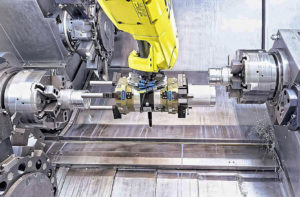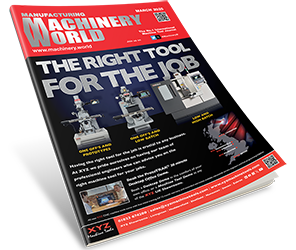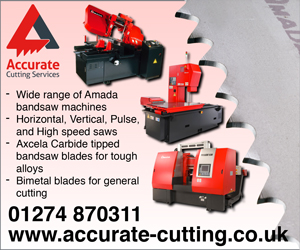Leonard Euler: “A new CNC machine is expensive, so you should make sure you really get the most out of it.”
German subcontractor Euler Feinmechanik, based in Schöffengrund, north of Frankfurt, has invested in three robotic machine tending systems from Halter in the Netherlands to automate loading and unloading of DMG Mori lathes. The Halter range of LoadAssistant robotic machine tending equipment is available in the UK through Salisbury-based 1st Machine Tool Accessories (www.1mta.com).
Established more than 60 years ago and with around 75 employees, Euler Feinmechanik machines complex turned and milled parts such as optical bearing mounts, components for camera lenses, rifle scopes for hunting and the military, medical and aerospace parts, and housings and stators for vacuum pumps. Materials machined are mainly aluminium, brass, stainless steel and various plastics including PEEK, acetal and PTFE.
Managing director Leonard Euler explained, “Our production processes include milling, but are centred mainly on CNC turning of prototypes, pre-production batches and series parts.
“We develop product-specific manufacturing strategies for our customers, for example Airbus, Leica and Zeiss, and support them from the development and production stages through to surface finishing and assembly.
“Automation and robotisation are important aspects of our continuous improvement. We are constantly thinking about whether we can optimise individual processes so that they interface even more smoothly.”
In 2016, Euler Feinmechanik bought a new CTX beta 800 4A CNC turn-mill centre from DMG Mori for the production of particularly complex components for vacuum equipment. The company knew at the time that it wanted to automate the machine, but first had to establish a reliable process to produce the workpieces to the required high quality.
That was the responsibility of Marco Kühnl, senior technician and team leader of the turning department. He said, “In view of the increasing order quantities for the components, we purchased our first loading robot in 2017. It has allowed us to increase productivity from the new DMG Mori lathe while getting labour costs under control.”
Several brands of machine tending equipment were considered, as Mr Euler was keen to find the best solution and make a future-proof choice on which the subcontractor could standardise.
He added, “DMG Mori itself was also in the running, as it had just introduced its own Robo2Go robot. This seemed to us to be the most logical combination and it is indeed a nice product, but it can only be programmed when the lathe is not running.
“However, Halter is a specialist in this field and not only had a good automation solution, but also great references and a working demonstration that showed exactly what we wanted. In the end, we opted for one of its Universal Premium 20 cells.”

Machining area of a CTX beta 800 4A, showing the Fanuc robot of the LoadAssistant deploying a double gripper for loading and unloading components.
There were various reasons for the decision, one of which was the use of high quality components in the construction, such as a Fanuc robot, Schunk grippers and a laser safety system from Sick. Additionally, the robot cell is manufactured in Halter’s factory in Germany, where the software is also developed.
As the manufacturer uses its own operating system, programming the cell while the robot is running is straightforward. In addition, while the robot is loading the machine at the front of the cell, an operator is able to insert raw material into the system from the rear and remove machined parts. Being able to do all this simultaneously avoids having to stop the turning centre and lose production.
Moreover, the mobile Universal Premium 20 can be moved quickly from one machine tool to service another, providing a high degree of production versatility on the shop floor.
The cell is designed for automatic loading of billets and unloading of machined workpieces to a maximum diameter of 270 mm. A customer can choose from a large selection of grid plates of different capacities for buffer storage, which accommodate rectangular as well as round workpieces and tall parts.
To facilitate connection of the loading robot to the CTX beta 800 4A, Halter equipped the machine with an automation interface. This service is a big advantage compared that provided by competitors. Halter is able to interface with any brand of CNC machine, regardless of its type and year of manufacture.
The DMG Mori lathe is primarily used for machining components from 130 mm to 150 mm diameter. Owing to its twin-spindle configuration, two workpieces can be produced in parallel. After automating the machine with the Halter cell, productivity increased by about 25 percent.
A year after purchasing the first DMG Mori turning centre and retrofitting it with automated loading and unloading, Euler Feinmechanik bought two more lathes from the same source. One is another CTX beta 800 4A, while the second is a smaller CLX 350 devoted to producing about 40 different components for the optical industry.
The two new machines were immediately equipped with Industry 4.0-compliant Halter loading robots identical to the first. Production on all three twin-spindle lathes can continue unattended for an average of half a shift, which maximises productivity and reduces labour costs.
Automation has improved production efficiency to such an extent that the subcontractor intends to continue automating its plant. A Halter LoadAssistant is planned for an existing DMG Mori lathe on the shop floor and asking Halter to add additional functions like workpiece polishing and grinding to the automation cells is being considered.
Confident of the future, Mr Euler concluded, “Automation has improved the utilisation of our CNC machines, increased output and quality, and reduced our hourly rates. The lower cost of production plus even faster, more reliable delivery have strengthened our competitiveness.
“Without unscheduled machine downtime we can plan production better and are no longer so reliant on staff being present, so we can more easily handle holidays and absences due to illness.
“Automation also makes jobs more attractive, so it is easier to find staff. Younger employees in particular show great interest in and commitment to the technology.”







